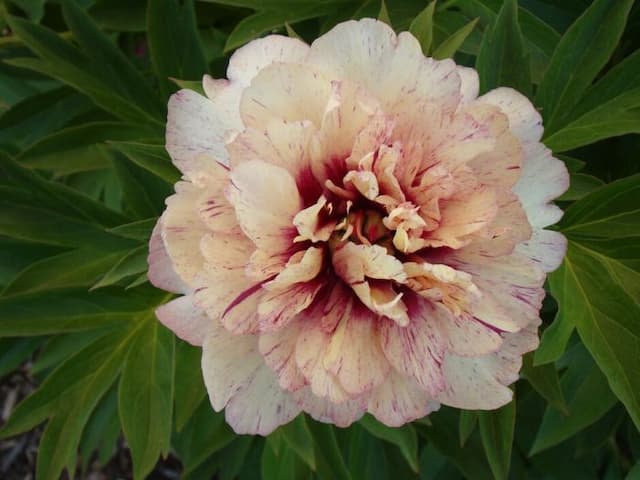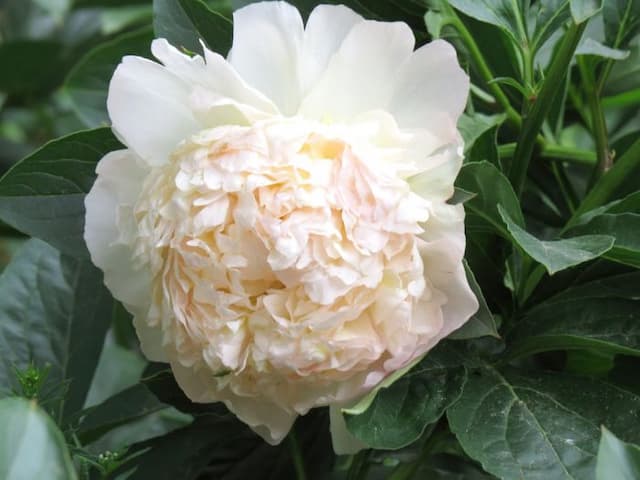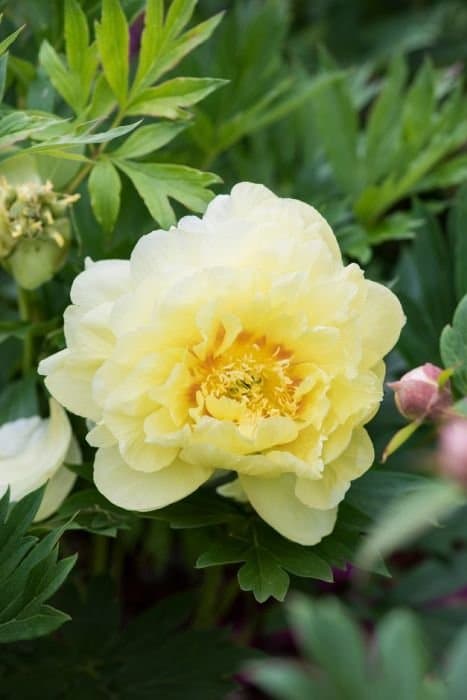Peony Paeonia lactiflora 'Lord Kitchener'

ABOUT
The common name for Paeonia lactiflora 'Lord Kitchener' is peony. This variety features large, aromatic blooms that embody a showy display. The flowers are typically a rich, deep pink color with numerous layers of velvety petals that unfurl into a rounded, full blossom. At the center of each flower, a cluster of contrasting yellow stamens adds a striking detail, creating a beautiful focal point. The foliage of 'Lord Kitchener' peonies is an attractive deep green, providing a lush backdrop for the dramatic flowers. The leaves are broadly lance-shaped, with a slight sheen on the surface, and are organized in a dense clump, offering a robust and bushy appearance. The stems are strong and erect, giving good support to the heavy flower heads, which tend to bow gracefully under their own weight, especially after a rain when the petals are laden with water droplets. Overall, the appearance of 'Lord Kitchener' peonies is one of opulence and romance, evoking the classic charm synonymous with these timeless garden favorites. The intoxicating fragrance they emit and their sumptuous blossoms make them coveted by gardeners and floral enthusiasts alike.
About this plant
 Names
NamesFamily
Paeoniaceae.
Synonyms
Chinese Peony, White Peony.
Common names
Paeonia lactiflora 'Lord Kitchener'.
 Toxicity
ToxicityTo humans
Peony (Paeonia lactiflora 'Lord Kitchener') has a low level of toxicity to humans when ingested. It’s generally considered safe when handled and is commonly used in gardens. However, peony parts contain compounds that may cause mild gastrointestinal upset if consumed in large quantities. Symptoms of poisoning can include nausea, vomiting, and diarrhea. While these effects are generally not severe, it is advisable to avoid ingesting any parts of the plant.
To pets
Peony (Paeonia lactiflora 'Lord Kitchener') is also considered to have low toxicity for pets. If cats, dogs, or other domestic animals ingest peony, they might experience mild gastrointestinal upset, including symptoms such as vomiting or diarrhea. These symptoms are typically not severe but can cause discomfort to the animal. It's a good practice to keep pets from consuming plants in general to avoid any potential issues.
 Characteristics
CharacteristicsLife cycle
Perennials
Foliage type
Deciduous
Color of leaves
Green
Flower color
Red
Height
2-3 feet (60-90 cm)
Spread
2-3 feet (60-90 cm)
Plant type
Herb
Hardiness zones
3-8
Native area
China
Benefits
 General Benefits
General Benefits- Ornamental Value: Paeonia lactiflora 'Lord Kitchener', commonly known as peony, displays large, striking flowers that provide aesthetic appeal to gardens and landscapes.
- Long Bloom Season: Peonies have a relatively long flowering period which ensures a display of color and beauty in the garden for an extended time during late spring to early summer.
- Attracts Pollinators: The peony's flowers attract bees and other beneficial pollinators, aiding in the health of the garden ecosystem.
- Drought Tolerance: Once established, peonies are relatively drought tolerant, which makes them suitable for gardens in regions with water scarcity.
- Perennial Growth: Being a perennial plant, peonies come back year after year, which reduces the need for annual replanting and maintenance.
- Cold Hardiness: Peonies are able to withstand cold climates and are hardy in a wide range of USDA zones, making them versatile for many gardeners.
- Variety of Uses: They are not only suitable for garden beds but also make excellent cut flowers for indoor arrangements.
- Easy to Care For: Peonies generally require minimal care once established, other than regular watering and the removal of spent flowers.
- Longevity: Peonies are known for their long lifespan, with some plants known to thrive for 100 years or more in the right conditions.
- Symbolism and History: Peonies carry various cultural significances, often symbolizing wealth, honor, and nobility, adding a layer of historical and emotional resonance to their planting.
 Medical Properties
Medical PropertiesThis plant is not used for medical purposes.
 Air-purifying Qualities
Air-purifying QualitiesThis plant is not specifically known for air purifying qualities.
 Other Uses
Other Uses- Paeonia lactiflora 'Lord Kitchener', commonly known as peony, can be used in fabric dyeing, providing an array of pink and cream colors depending on the mordant used.
- The petals can be pressed and used in crafts for card making or in resin jewelry to capture the flower's beauty.
- Peony petals can be frozen in ice cubes to create visually stunning additions for summer drinks and cocktails.
- Flower arrangers use peonies as a natural source of inspiration and as a focal point in floral design workshops.
- The peony's strong stems make it suitable for constructing natural fences in artistic garden designs.
- Dried peony petals serve as an ingredient in homemade potpourri blends, mixing with other dried flowers and spices.
- In some cultures, peony petals are used to decorate festive cakes or desserts, adding an elegant, edible garnish.
- Peony flowers can be used as a natural fabric freshener when dried and placed in linen closets.
- The vibrant bloom is often a subject for photographers and painters who wish to capture the essence of spring in their art.
- Peony petals can be infused in water to create delicately scented bathing water for a luxurious spa-like experience.
Interesting Facts
 Feng Shui
Feng ShuiPeony is not used in Feng Shui practice.
 Zodiac Sign Compitability
Zodiac Sign CompitabilityPeony is not used in astrology practice.
 Plant Symbolism
Plant Symbolism- Prosperity: Peonies are often associated with wealth and good fortune, making them popular in cultures that value material success.
- Honor: The 'Lord Kitchener' variety could evoke a sense of honor and nobility, a tribute to its namesake who was a respected British military leader.
- Romance: Peonies are frequently used in weddings and romantic occasions as symbols of happy marriage, love, and affection.
- Beauty: With its large, lush blooms, peonies are considered a symbol of beauty and elegance in the plant world.
- Healing: Traditionally, peonies were used for their medicinal properties, thus being a symbol of healing and good health.
 Water
WaterPeonies, including the 'Lord Kitchener' variety, should be watered deeply once a week during their growing season if there hasn't been substantial rain. The method of watering should be at the base of the plant to avoid wetting the foliage, which can lead to fungal diseases. In general, provide about an inch of water, which translates to approximately 0.6 gallons for each square foot. During the hot summer months, you may need to water more frequently, especially if you notice the soil drying out quickly.
 Light
LightPeonies like 'Lord Kitchener' thrive best in full sun to partial shade, with at least six hours of sunlight a day. They perform optimally when planted in a spot where they receive early morning sun, which helps dry dew from the leaves, thereby reducing the risk of fungal diseases. Avoid deep shade as it can impede flowering and overall growth.
 Temperature
TemperatureThe peony 'Lord Kitchener' is hardy and can survive winter cold down to temperatures of around -20 degrees Fahrenheit. Optimal growth occurs when spring and summer temperatures are between 65 and 75 degrees Fahrenheit; however, they can tolerate summer highs up to 85 degrees Fahrenheit. It's important to provide a period of winter chill for successful budding in the spring.
 Pruning
PruningPeonies such as 'Lord Kitchener' should be pruned to remove spent blooms immediately after flowering to conserve the plant's energy. In the fall, after the first frost, cut back the foliage to the ground to prevent overwintering diseases. Peonies should also be deadheaded to encourage healthy growth and potentially more blooms the following year.
 Cleaning
CleaningAs needed
 Soil
SoilThe best soil mix for the peony 'Lord Kitchener' consists of well-drained, fertile loam with compost incorporated. It should have a neutral to slightly alkaline pH, between 6.5 and 7.5. Avoid heavy or waterlogged soils as peonies require good drainage to thrive.
 Repotting
RepottingPeonies like 'Lord Kitchener' rarely need repotting as they prefer to be undisturbed and can thrive in the same location for many years. Only repot or divide them if they become overcrowded, typically every 10-15 years.
 Humidity & Misting
Humidity & MistingPeonies such as 'Lord Kitchener' are tolerant of a range of humidity levels and do not require specific humidity conditions. They thrive well in average outdoor humidity found in their growing zones.
 Suitable locations
Suitable locationsIndoor
Provide bright light and cool temps for indoor peony 'Lord Kitchener'.
Outdoor
Plant in sun to part shade, ensure good drainage.
Hardiness zone
3-8 USDA
 Life cycle
Life cycleThe Paeonia lactiflora 'Lord Kitchener', also known as Chinese peony, starts as a seed that requires stratification to break dormancy. After sprouting in early spring, it develops into a seedling with several tri-foliate leaves. Throughout the spring and into early summer, the plant grows vegetatively and stores energy in its underground tuberous root, and by late spring, the plant flowers, producing large, fragrant pink blooms that attract pollinators. Once flowering ceases, the plant enters a period of energy accumulation where the foliage photosynthesizes to replenish the roots for the next cycle. In autumn, the plant's above-ground foliage begins to wither and die back as it enters dormancy for the winter months. The cycle restarts the following spring when the temperatures rise and the plant emerges again from its roots.
 Propogation
PropogationPropogation time
Spring to summer
Paeonia lactiflora 'Lord Kitchener', commonly known as Chinese peony, is most effectively propagated through division, which is best undertaken in the fall as the plant becomes dormant. To propagate by division, carefully dig up the peony clump and gently shake off the excess soil. Look for natural divisions in the root system—each division should have at least three to five eyes, which are the growth nodes for new stems. Using a sharp knife or spade, cut the clump into smaller sections, ensuring that each division has a portion of the root system attached. Replant these divisions promptly at the same depth they were originally growing, no deeper than 2 inches (about 5 cm), and water well to help establish the roots. This method encourages vigorous growth in the spring and is the preferred way to expand your collection of these beautiful, traditional garden favorites.





![Peony [Red Sarah Bernhardt]](/_next/image?url=https%3A%2F%2Fplants-admin.emdemapps.com%2Fimages%2Fplants%2F%2Fimages%2F604b5369d170e.png&w=640&q=75)



